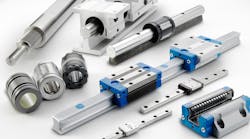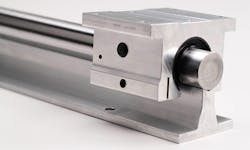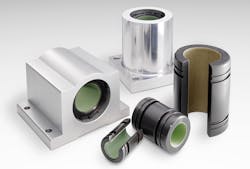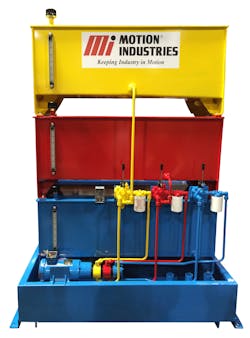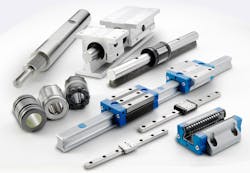Four Lubrication Mistakes that can Bring Machines Down
In linear motion applications, bearings and guides require proper lubrication to ensure efficient operation. A lack of investment in a lubrication management program can contribute toward maintenance costs and downtime. To help establish this type of program and steer clear of premature machine failure, here are four common lubrication mistakes and tips for avoiding them.
Using the Wrong Lubricants
Identifying the right type of lubricant for any given application can be difficult. Notwithstanding application and mechanical considerations, there’s also a wide variety of available lubricant options to wade through. New and changing additive packages make this exercise all the more challenging.
For linear bearing and guides, selecting the right lubricant at the outset is critical. Using the wrong one shortens operating life (best case) or causes catastrophic failures (worst case).
Selecting the appropriate lubrication for an application directly influences the performance and life of linear bearing and guides. (Courtesy:Thomson Industries)
A few general guidelines that will help you select the right option:
- Light loads and high speeds do well with machine oil or low-viscosity grease.
- Medium loads and speeds do well with NLGI 1 or 2 grease. (The number indicates the grease’s relative hardness as per the National Lubricating Grease Institute.)
- High loads may require a grease with an EP2 additive. (EP stands for “extreme pressure” and it uses additives that prevent grease from breaking down under high pressures.) This type of grease gives steel shafts a dull appearance.
Other additive types that you might come across:
- Antioxidants protect grease during storage and extend life at increased temperatures.
- Rust and corrosion inhibitors prevent metal oxidation and stop the grease from attacking metals.
- Tackifiers/polymers allow for better adhesion to metal surfaces by providing water resistance.
- Solid lubricants such as moly (made from the mineral molybdenite), polytetrafluoroethylene (PTFE), and graphite protect against friction and wear during boundary lubrication conditions.
Linear slide tables should be lubricated per the manual. Using a different grease than what was supplied at the factory can cause the grease to degrade. Do not use any type of dry lubricant (PTFE or graphite powder) with recirculating ball- or roller-type bearings. Although these lubricants are good for sliding motion, they do little to reduce rolling friction.
For some applications, including those difficult or unsafe to access for routine maintenance or in highly contaminated environments, self-lubricating bearings are ideal. (Courtesy:Thomson Industries)
Once designers have considered these factors, they must now decide between oil or grease for bearing lubrication.
In general, the heavier the lubricant, the greater it protects against contamination, which means grease tends to provide more protection than oil. However, this must be balanced against other application criteria. For applications subject to dust, fumes, and other contamination, grease should always get first consideration. Grease maintains consistency over longer periods of time, making it better than oil for extended operations with minimal maintenance.
However, at high speeds and temperatures, grease doesn’t perform as well as oil. Oil viscosity typically decreases rapidly as operating temperatures increase. There are at least four common viscosity values measured at temperatures ranging from 100-212°F (38 to 100oC). The challenge is selecting one that provides a minimum acceptable viscosity at the bearing’s operating temperature. There should be enough viscosity to form fluid films at the prevailing shear rates, but not so much that it causes excessive friction.
Cross-contamination of incompatible greases and oils can have severe ramifications, so it is critical machine designers select the right lubrication type.
It is also a good idea to consult with the machine designer and your lubrication supplier/specialist to identify the right products for your equipment.
Doing all this research upfront may seem daunting, but it will reap great benefits by extending the life of your machine.
In the final stages of production, this custom-designed fluid containment system for a mining operation lets end-users identify and segregate each fluid by color to avoid any possibility of cross-contamination. (Credit: Motion Industries)
Neglect Maintenance
Waiting for machine components to break before fixing it is not a good idea. It means unscheduled downtime, which means lost productivity. A structured lubrication schedule can prevent this by extending bearing life and driving part-replacement programs. A comprehensive lubrication plan combines manual and visual inspection, condition monitoring, and self-lubricating bearings.
Manually and visually inspecting the lubrication is the first line of defense against downtime. It begins with a visual check of the raceway and shafts to see if there is a consistent, thin film of lubrication throughout or if there is more lubrication than necessary. Maintenance staff may also gauge the lubrication’s adequacy by gliding a finger across the bearing shaft. It should feel slick but not dripping. This quick manual check can also reveal the presence of metal particles, which indicates excessive wear
The effectiveness of manual and visual inspection depends on the experience, training, and judgment of the maintenance personnel. They should know how much lubrication is right for different travel requirements, loads, and environmental conditions. What is most important, however, is that the inspection is not random but scheduled at set intervals. During inspections, maintenance teams might also detect signs of wear, such as excessive noise or increased vibration.
As the costs of instrumentation and connectivity come down, inspections can be more automated. Optical sensors can detect the presence or absence of lubrication and trigger alarms if they’re inadequate for the load and travel distance. Sensors can detect the slightest increase in friction or vibration caused by inadequate lubrication or wear.
In many applications, self-lubricating bearings are becoming more common. They store lubrication in internal reservoirs and deposit or remove it as necessary. They are ideal for installations that are difficult or unsafe to access for routine maintenance. In some cases, the reservoir can be refilled to last the life of the bearing.
Other factors affect bearing life as well, so even companies using self-lubricating bearings should create and stick to routine inspection schedules.
Proper preventive maintenance programs also detect contamination of bearings and guides. Selecting the right lubrication protects against contamination by keeping out foreign materials. Machine designers can also add built-in features to their designs that reduce any risks of contamination. For example, bellows are an effective, yet space-consuming, protective feature. They can be specified to cover the bearing and moving parts, making contamination impossible unless the bellow’s folds break or split. For many applications, wipers continually clean the bearing shafts. Scrapers provide a similar service on heavier types of debris.
No matter the type of linear bearings and guides specified for a machine, proper training on lubrication and a lubrication management system is imperative for their effective maintenance. (Courtesy:Thomson Industries)
Violating Lubrication Protocols
Proper lubrication storage and transportation is critical. This is why setting up protocols for them merits a significant investment in time, effort, and money. Color-coded tagging of containment and transfer equipment keeps storage clean and orderly. Positioned throughout a facility, this serves as a daily, visual reminder of that facility’s commitment to the program. It also cultivates a culture among the employees that values good maintenance.
A widespread misconception that new oil is clean often leads to premature failure. The reality is that new oil will only have a minimum level of cleanliness. This level, typically provided in the ISO format, should be compared to requirements for the linear bearings and guides. It will show that new oil is not clean—or at least, not clean enough. The best way to combat this is to always filter lubricants when they are transferred from a barrel to bulk storage, from bulk storage to temporary containers, and from temporary containers to the equipment being serviced.
Designers should focus on:
- Installing and storing lubricants, bulk storage tanks, and transfer equipment in one clean area, preferably one with environmental controls that minimize the escape of airborne contaminants, stabilize temperatures, and control humidity. Placing this area in a location central to the facility, ideally near a storeroom or maintenance shop, saves time and labor by creating an efficient workflow.
- Color code everything: storage tanks, transfer equipment, and even the equipment being serviced. For example, it would be a good idea to have a yellow grease gun, yellow outlined pegboard in a bulk-lubricant storage area, and a yellow tag showing the grease name and type hanging on all equipment it gets put in or on. Color coding for lubricant distribution makes for an easy-to-use and intuitive system. It may seem like a laborious task, but there are many ready-made labels and tags that can be quickly and easily ordered and installed.
- Invest in high-quality equipment. Maintenance personnel are more likely to buy into the program if they see management has made a considerable investment. In addition, buying premium components saves a facility significant money over time.
- Use quality filtration and closed transfer points to protect oil from airborne contaminants. Filtration and breathers, preferably desiccant style, pay for themselves and keep fluids clean when they are most exposed. Closed transfer points, using fluid quick couplers, ensure clean transfers and minimize the potential for human error.
Inadequate Training
Training is often overlooked when it comes to investments and spending. This can lead to issues during start-up or even persist throughout the life of the machine being purchased. This is particularly true for equipment that relies on linear bearings and guides. Most maintenance staff are not as familiar or comfortable with maintaining linear bearings. They need a little instruction. Failure to invest in appropriate training leads to neglect and improper maintenance, reducing the operating life of the machine.
At the heart of a facility’s maintenance program should be a well-thought-out lubrication management system which relies heavily on education and continuous improvements. Investing time in this style of accreditation and training saves facilities time and money, and ensures your staff is properly educated and armed with the tools to maintain the machine they service.
Several good training courses and accreditations currently exist and are available for maintenance staffs. The International Council for Machinery Lubrication (ICML), for example, a vendor-neutral, not-for-profit organization offers several well-regarded courses.
Understanding the primary causes of machine failure and how to avoid them is of great value for machine designers as well as end-user maintenance teams. Furthermore, understanding how lubrication and its characteristics apply to linear bearings and guides is critical. If a proper preventive program is followed, end-users benefit from lower lifecycle costs and longer lives of high-precision linear motion components.
Charles Isaac is global product line manager, linear bearings and guides for Thomson Industries. Ian Miller is national services business development manager of Motion Canada. To find out more about lubrication visit Motion System’s MiHow2.com (instructional videos).
